The Influence of Soldering Profile on the Thermal Parameters of Insulated Gate Bipolar Transistors (IGBTs)
Abstract
1. Introduction
2. Materials and Methods
2.1. Sample Preparation
2.2. Thermal Measurements
- Calibration of the thermometric characteristic. The characteristic describes the dependence of a thermo-sensitive parameter on temperature. The calibration was performed at a closed switch (S1). The measurement current (IM) of 1.3 mA flowed through the transistor. During calibration, the temperature of the transistor was regulated by a thermostat, in which the device being tested was situated. The slope of the thermometric characteristic was calculated on the basis of this characteristic;
- Heating. In the second step of measurements, the heating power was dissipated in the transistor operating within the active range, and its internal temperature increased as a result of self-heating. In this stage, switch (S1) was opened. The current IH flowed through the self-heating device. This step ended after a thermally steady-state was obtained. At this point, junction temperature of the transistor should be around 100 °C. At the steady-state, the value of the voltage drop (VCE) in the self-heating device was measured. The value of heating power (PH) was equal to the product of the voltage drop of the self-heating device and current IH. In the case of the performed measurements, it was equal to 4.9 W;
- Cooling. This step began after the change in the state of the switch S1 at time t = 0 and meant the measurement of the waveform of the thermo-sensitive parameter until the steady-state was obtained. Then, the current flowed through the transistor, which was equal to the calibration value. VGE voltage was measured at defined time intervals with an analogue-to-digital (A/D) converter and recorded by a PC. The waveform of junction temperature (Tj) of the IGBT were calculated according to the use of the thermometric characteristic measured during calibrations and the waveform of voltage VGE(t) measured in the third step of measurements. Finally, the transient thermal impedance was calculated using the following equation:where Tj is junction temperature, Ta is ambient temperature and PH is heating power.
2.3. Investigations of the Solder Joints
3. Results and Discussion
4. Conclusions
Author Contributions
Funding
Institutional Review Board Statement
Informed Consent Statement
Data Availability Statement
Conflicts of Interest
References
- Illés, B.; Horváth, B. Tin Whisker Growth from Micro-alloyed SAC Solders in Corrosive Climate. J. Alloys Comp. 2014, 616, 116–121. [Google Scholar] [CrossRef]
- Diehm, R.; Nowottnick, M.; Pape, U. Reduction of voids in solder joints an alternative to vaccum soldering. In Proceedings of the IPC APEX EXPO, San Diego, CA, USA, 28 February–1 March 2012. [Google Scholar]
- Iwamuro, N.; Laska, T. IGBT history, state-of-art and future prospects. IEEE Trans. Electron Devices 2017, 64, 741–752. [Google Scholar] [CrossRef]
- Baliga, B.J. Fundamentals of Power Semiconductor Devices, 2nd ed.; Springer: Raleigh, NC, USA, 2019; pp. 755–756, 759–760. [Google Scholar]
- Du, M.; Guo, Q.; Ouyang, Z.; Wei, K.; Hurley, W.G. Effect of solder layer crack on the thermal reliability of Insulated Gate Bipolar Transistors. Case Stud. Therm. Eng. 2019, 14, 100492. [Google Scholar] [CrossRef]
- Zhu, Y.; Xiao, M.K.; Su, X.Z.; Yang, G.; Lu, K.; Wu, Z.H. Modeling of Conduction and Switching Losses for IGBT and FWD Based on SVPWM in Automobile Electric Drives. Appl. Sci. 2020, 10, 4539. [Google Scholar] [CrossRef]
- Choi, U.M.; Blaabjerg, F.; Jørgensen, S.; Iannuzzo, F.; Wang, H.; Uhrenfeldt, C.; Munk-Nielsen, S. Power cycling test and failure analysis of molded Intelligent Power IGBT Module under different temperature swing durations. Microelectron. Reliab. 2016, 64, 403–408. [Google Scholar] [CrossRef]
- Górecki, K.; Ptak, P. Influence of the area of a thermal pad on optical and thermal parameters of LED modules. Circuit World 2020, 46, 65–70. [Google Scholar] [CrossRef]
- Catalano, A.P.; Scognamillo, C.; d’Alessandro, V.; Castellazzi, A. Numerical Simulation and Analytical Modeling of the Thermal Behavior of single- and Double Sided Cooled Power Modules. IEEE Trans. Comp. Packag. Manuf. Technol. 2020, 10, 1446–1453. [Google Scholar] [CrossRef]
- Coombs, C.F., Jr. Printed Circuits Handbook, 6th ed.; McGRAW-HILL: New York, NY, USA, 2008. [Google Scholar]
- Jiang, M.; Fu, G.; Wan, B.; Xue, P.; Qiu, Y.; Li, Y. Failure analysis of solder layer in power transistor. Solder. Surf. Mount Technol. 2018. [Google Scholar] [CrossRef]
- Skwarek, A.; Illés, B.; Synkiewicz, B.; Wroński, S.; Tarasiuk, J.; Witek, K. Characterization of solder joints made with VPS on DBC substrate. J. Mater. Sci. Mater. Electron. 2017, 28, 1769–1776. [Google Scholar] [CrossRef]
- Nowottnick, M.; Novikov, A.; Pape, U. Material-und prozesseinfluesse auf die herstellung porenarmer loetverbindungen. SMT Hybrid Packag. Tutor. 2007, 11. [Google Scholar]
- Skwarek, A.; Ptak, P.; Górecki, K.; Hurtony, T.; Illés, B. Microstructure Influence of SACX0307-TiO2 Composite Solder Joints on Thermal Properties of Power LED Assemblies. Materials 2020, 13, 1563. [Google Scholar] [CrossRef] [PubMed]
- Busek, D.; Dusek, D.; Beran, T.; Vesely, P. Thermo-mechanical test of SnBi and SnCu solder joints on different surface finishes. In Proceedings of the 42nd IEEE-ISSE conference, Wroclaw, Poland, 15–19 May 2019. [Google Scholar] [CrossRef]
- Górecki, P.; Górecki, K. Measurements and Computations of Internal Temperatures of the IGBT and the Diode Situated in the Common Case. Electronics 2021, 10, 210. [Google Scholar] [CrossRef]
- Avenas, Y.; Dupont, L.; Khatir, Z. Temperature Measurement of Power Semiconductor Devices by Thermo-Sensitive Electrical Parameters—A Review. IEEE Trans. Power Eelctronics 2012, 27, 3081–3092. [Google Scholar] [CrossRef]
- Ptak, P.; Gorecki, K.; Skwarek, A.; Witek, K.; Tarasiuk, J. The influence of soldering process parameters on the optical and thermal properties of power LEDs. Solder. Surf. Mount Technol. 2020, 32, 191–199. [Google Scholar] [CrossRef]
- Catalano, A.P.; Trani, R.; Scognamillo, C.; d’Alessandro, V.; Castellazzi, A. Optimization of thermal vias design in PCB-based power circuits. In Proceedings of the 21st International Conference on Thermal, Mechanical and Multi-Physics Simulation and Experiments in Microelectronics and Microsystems EuroSimE, Cracow, Poland, 5–8 July 2020. [Google Scholar]
- Illés, B.; Géczy, A.; Skwarek, A.; Bušek, D. Effects of substrate thermal properties on the heat transfer coefficient of vapour phase soldering. Int. J. Heat Mass Trans. 2016, 101, 69–75. [Google Scholar] [CrossRef]
- Górecki, K.; Górecki, P. The Analysis of Accuracy of the Selected Methods of Measuring Thermal Resistance of IGBTs. Metrol. Meas. Syst. 2015, 22, 455–464. [Google Scholar] [CrossRef][Green Version]
- Susinni, G.; Rizzo, S.A.; Iannuzzo, F. Two Decades of Condition Monitoring Methods for Power Devices. Electronics 2021, 10, 683. [Google Scholar] [CrossRef]
- Yahaya, M.Z.; Nazeri, M.F.M.; Kheawhom, S.; Illés, B.; Skwarek, A.; Mohamad, A.A. Microstructural analysis of Sn-3.0Ag-0.5Cu-TiO2 composite solder alloy after selective electrochemical etching. Mater. Res. Express 2020, 7, 016583. [Google Scholar] [CrossRef]
- Zhang, Z.; Cao, H.; Xiao, Y.; Cao, Y.; Li, M.; Yu, Y. Electromigration-induced growth mode transition of anodic Cu6Sn5grains in CujSnAg3.0Cu0.5jCu lap-type interconnects. J. Alloys Compd. 2017, 703, 1–9. [Google Scholar] [CrossRef]
- Frederikse, H.P.R.; Fields, R.J.; Feldman, A. Thermal and electrical properties of coppertin and nickeltin intermetallics. J. Appl. Phys. 1992, 72, 2879–2882. [Google Scholar] [CrossRef]
- Greve, H.; McCluskey, F.P. Thermal conductivity of Cu-Sn transient liquid phase sintered interconnects for high power density modules. In Proceedings of the 2017 International Workshop on Integrated Power Packaging (IWIPP), Delft, The Netherlands, 5–7 April 2017; pp. 1–7. [Google Scholar]
- Lee, B.-S.; Yoon, J.-W. Cu-Sn Intermetallic Compound Joints for High-Temperature Power Electronics Applications. J. Electron. Mater. 2018, 47, 430–435. [Google Scholar] [CrossRef]

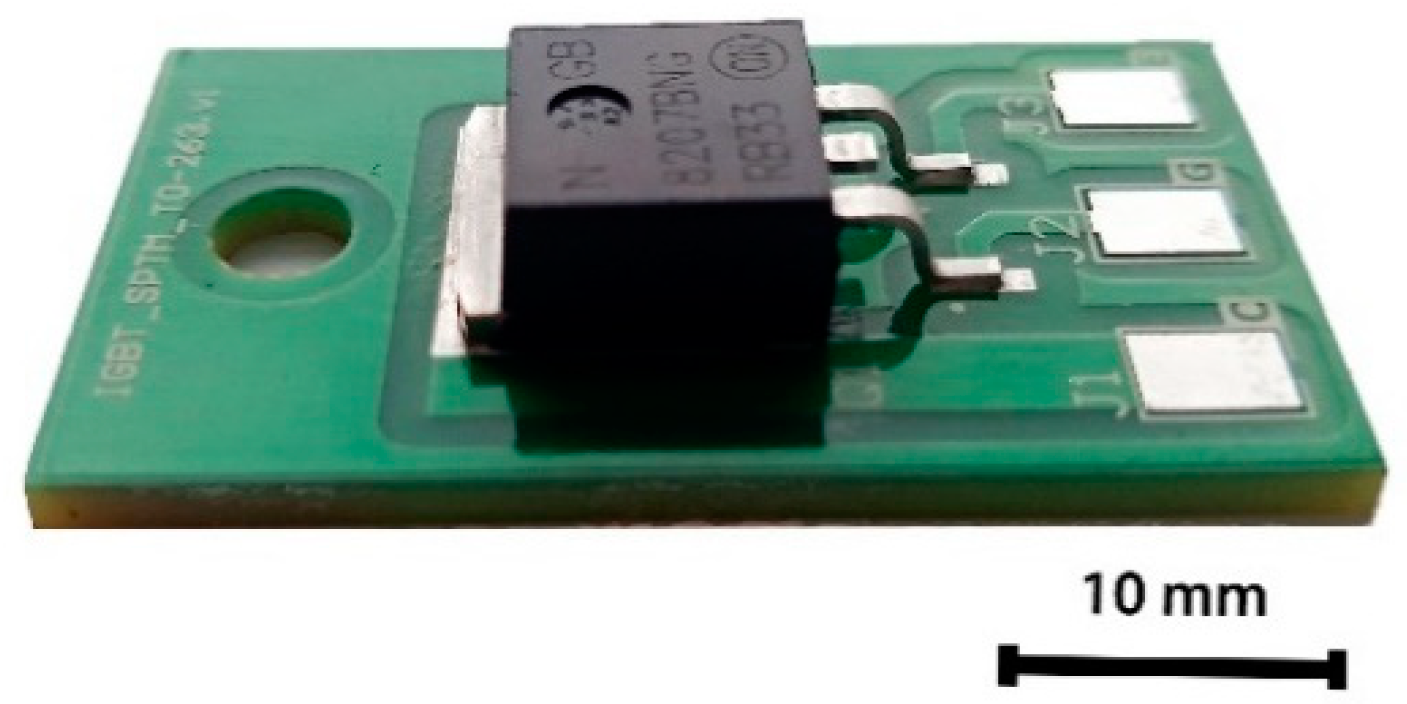
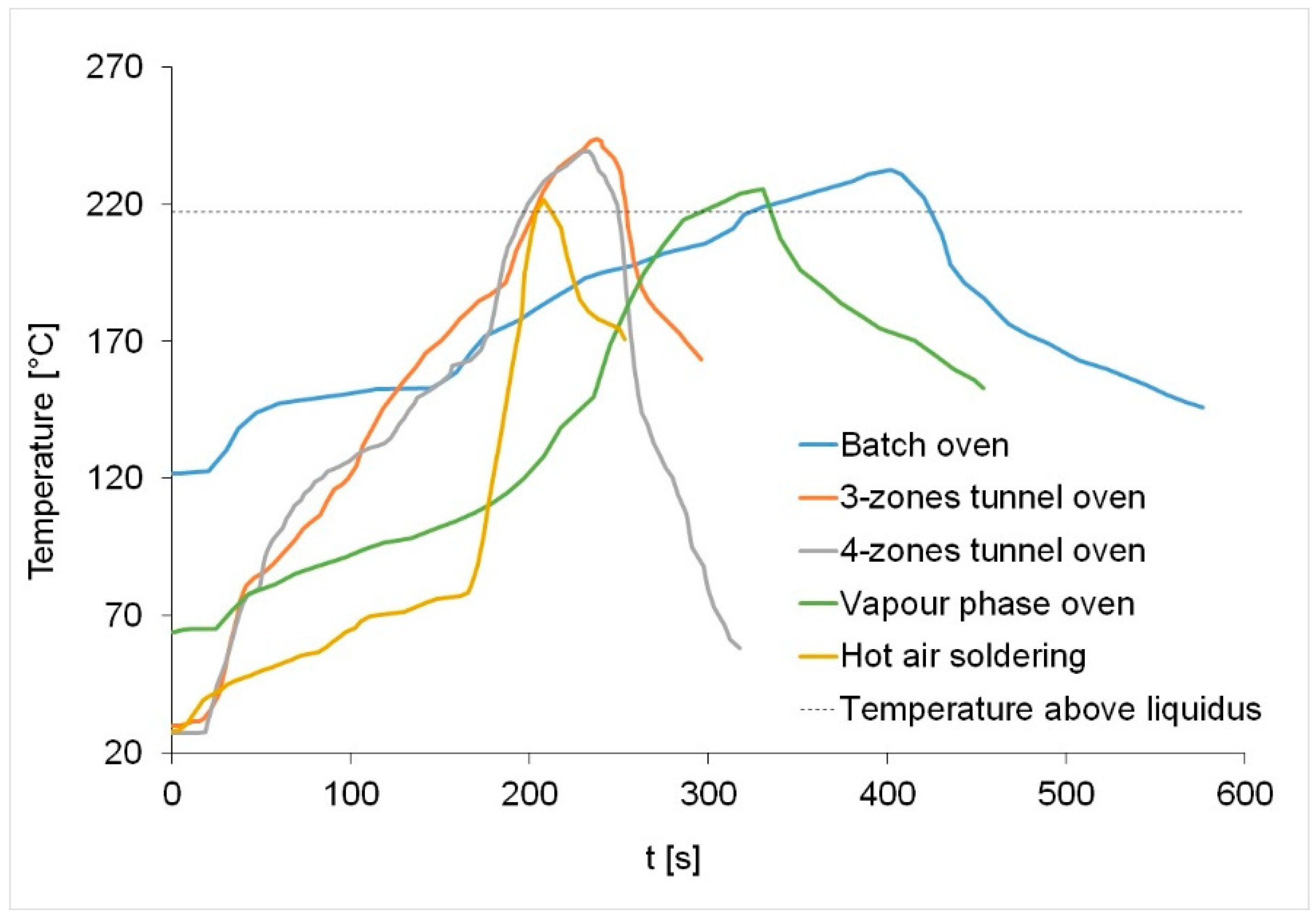



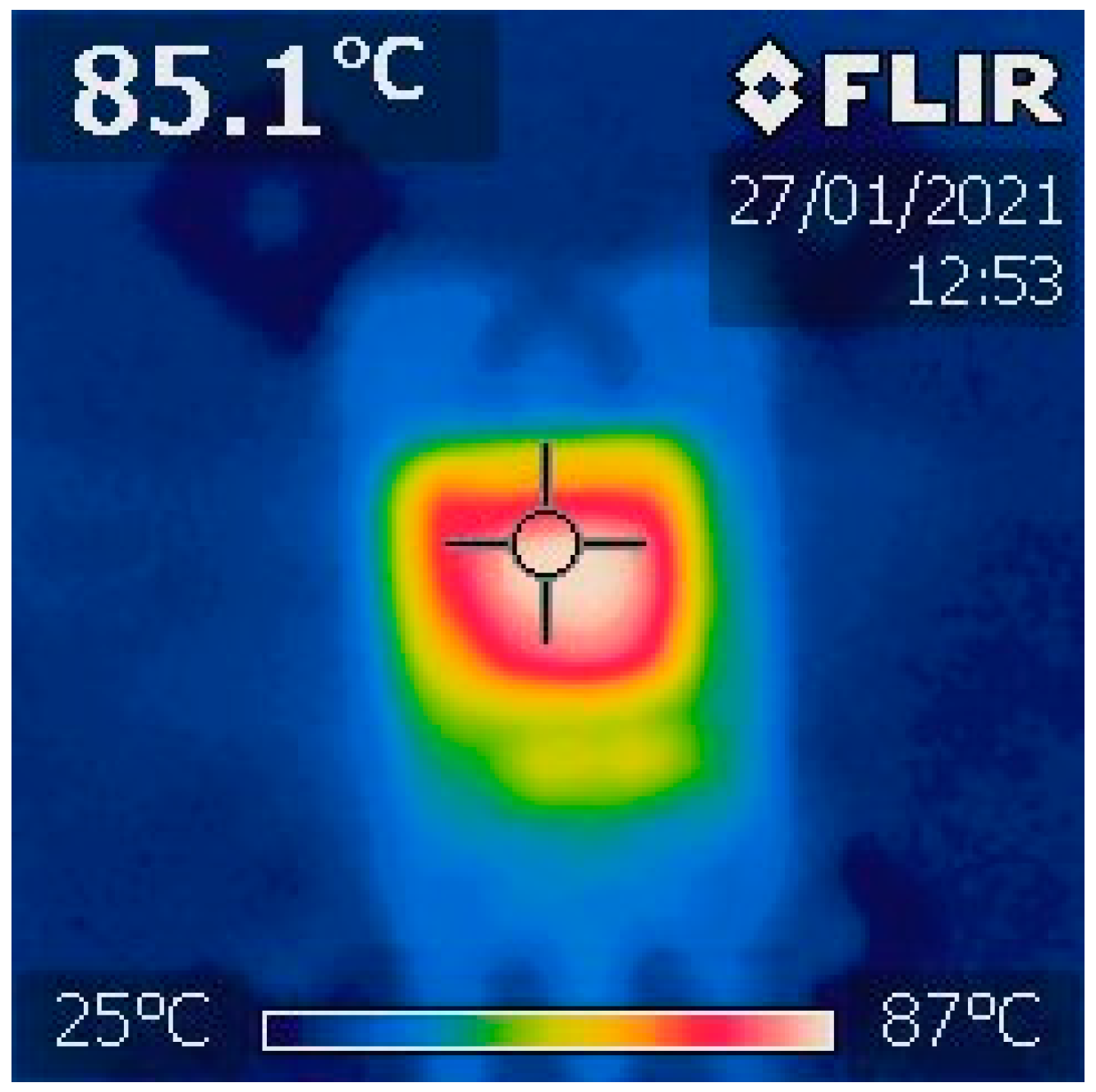
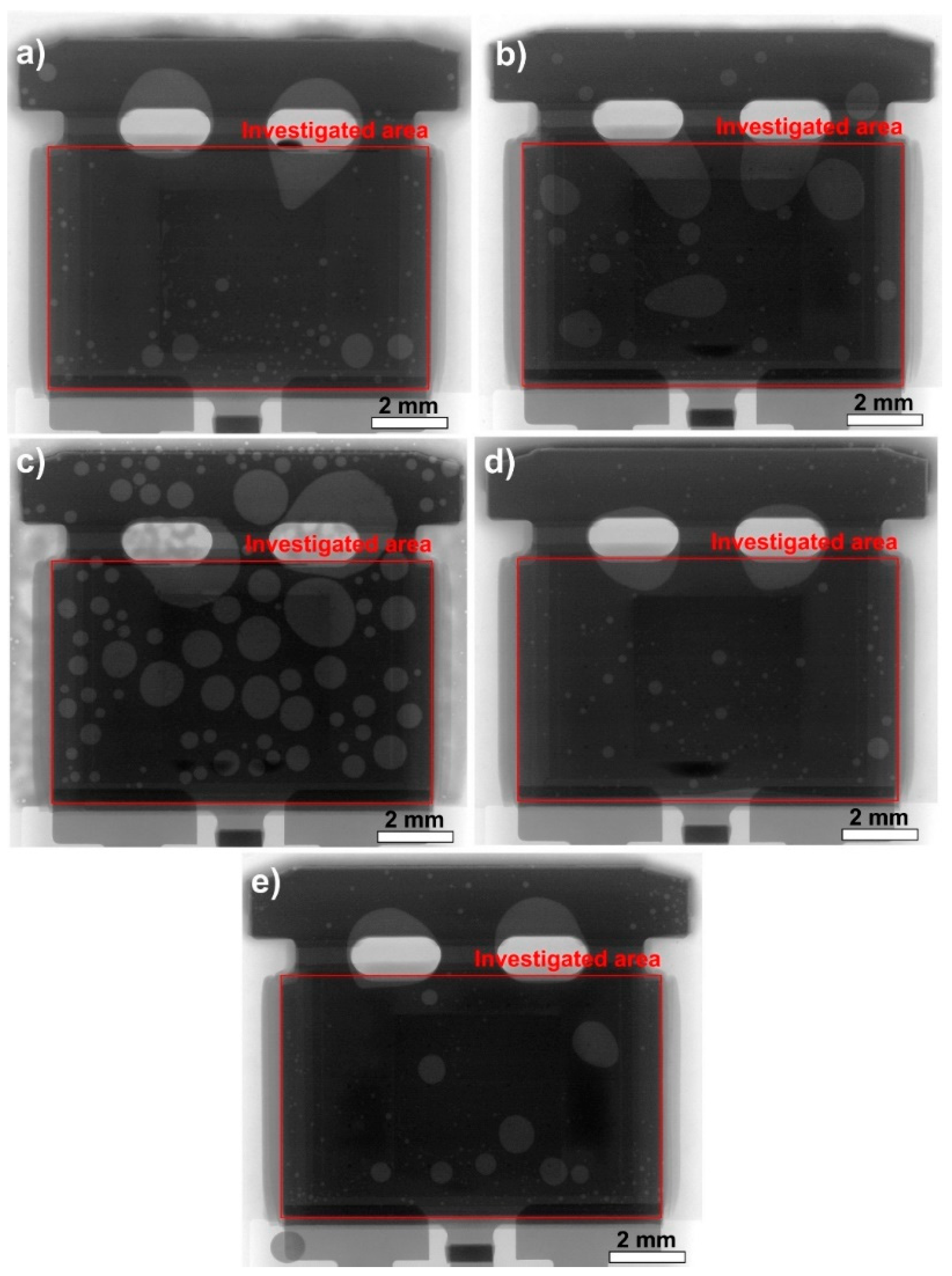
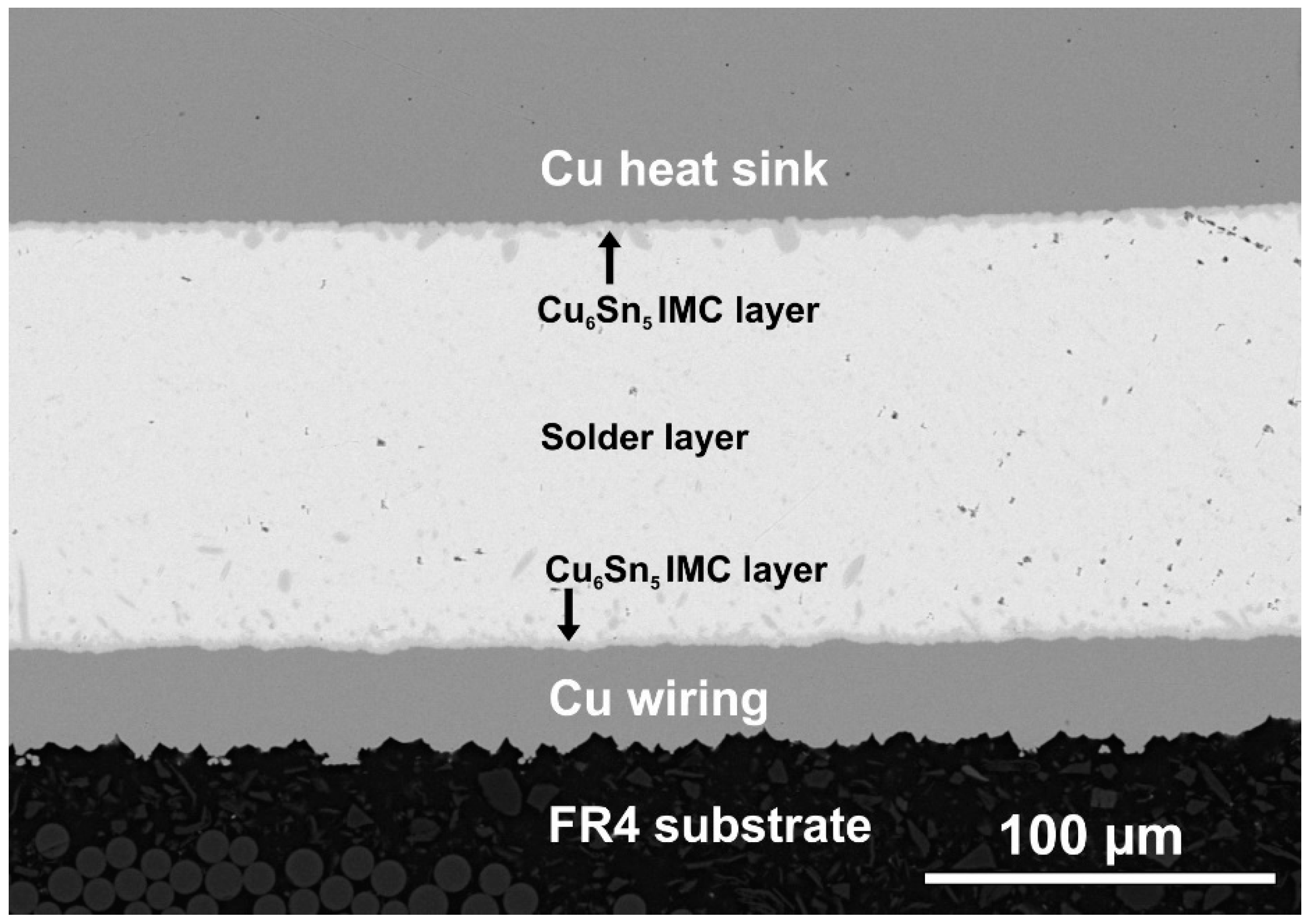
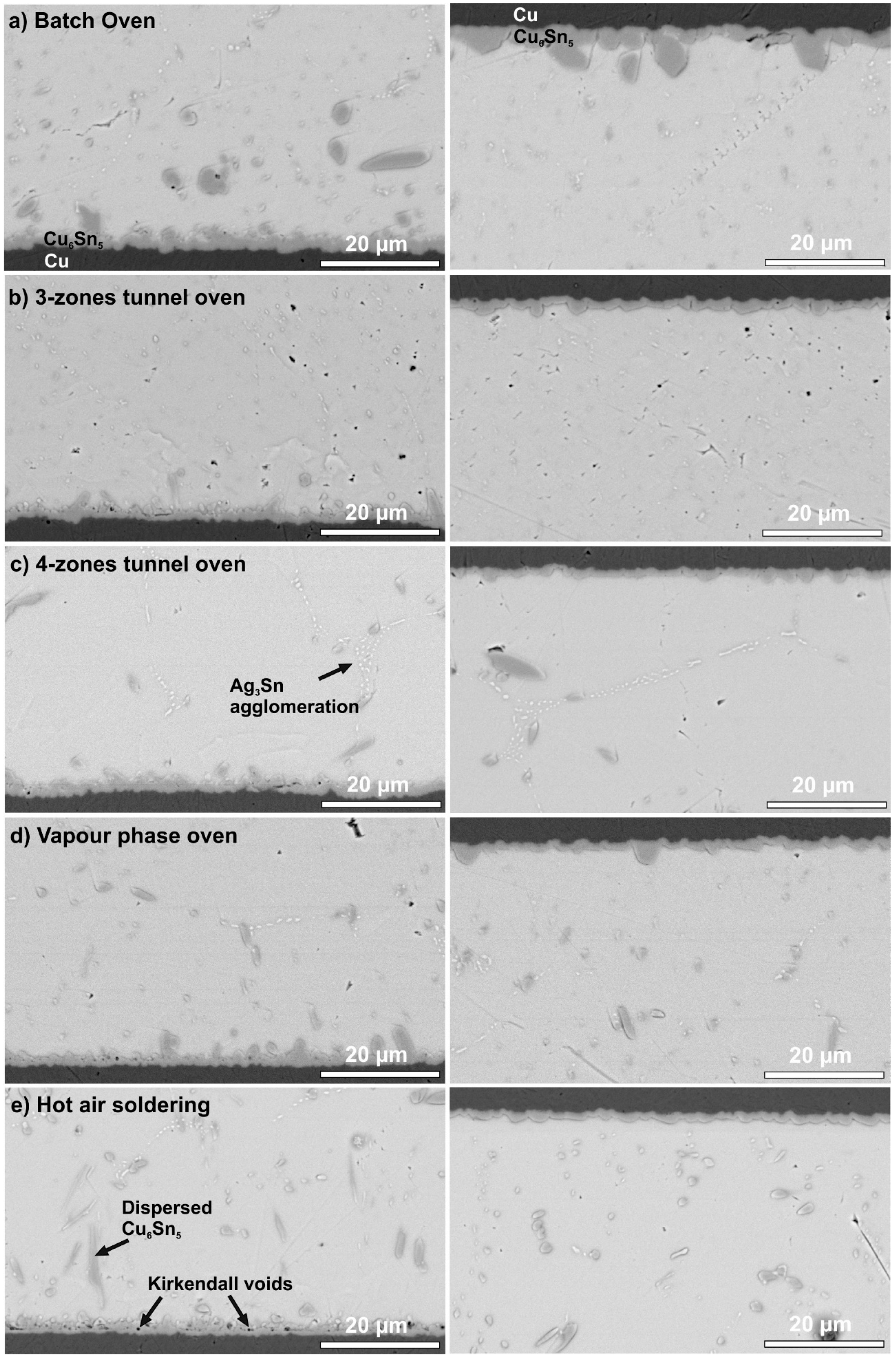
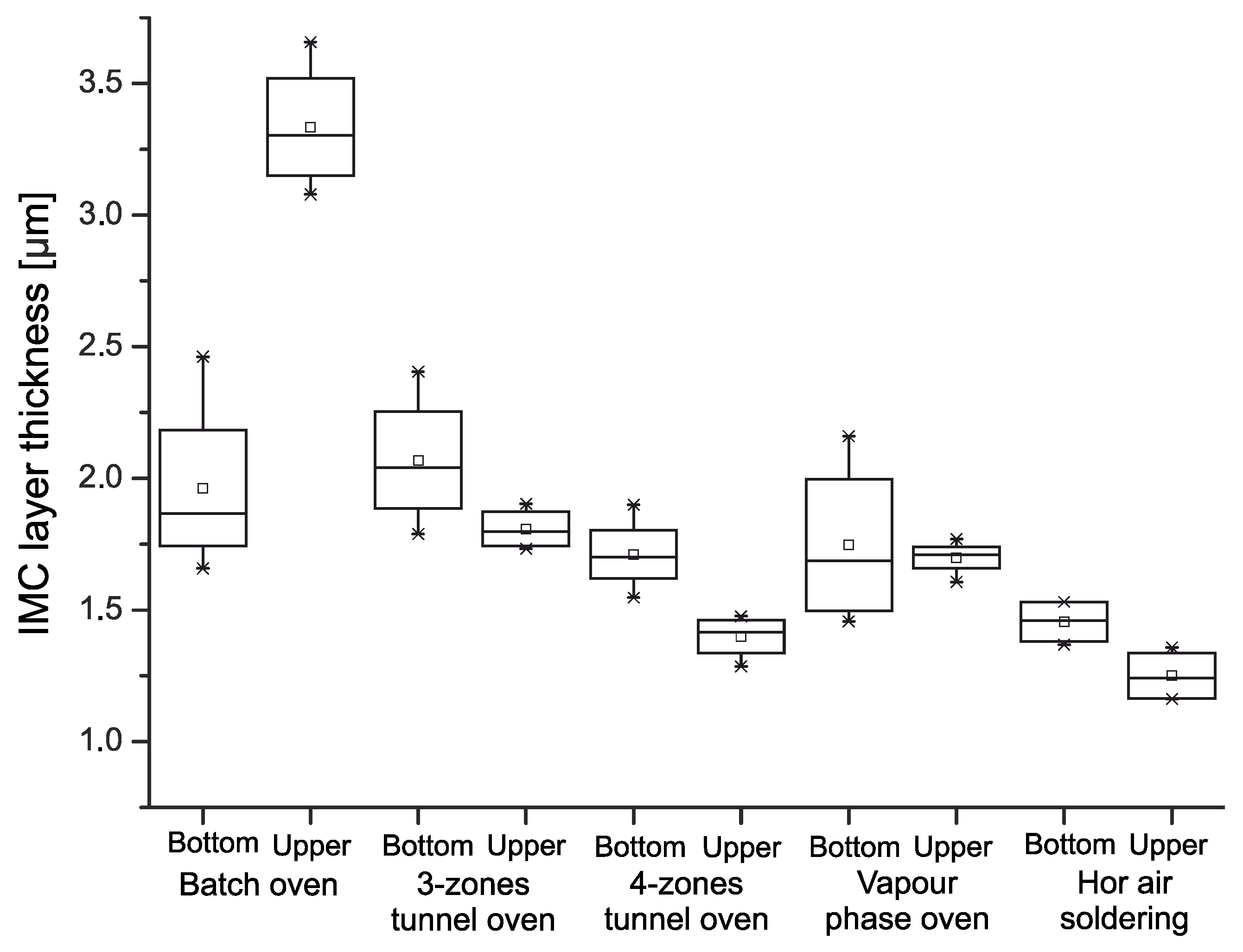
| Soldering | Type of Heating | Temperature (°C) | Time (s) | Atmosphere |
|---|---|---|---|---|
| Batch oven | Infrared radiation | pre-heating 150–180 | 140 | Air |
| reflowing 210–254 | 200 | |||
| cooling 254–170 | 180 | |||
| 3-zones tunnel oven | Convection | pre-heating 160–180 | 60 | Air |
| reflowing 213–247 | 40 | |||
| cooling 247–150 | 70 | |||
| 4-zones tunnel oven | Convection | pre-heating 140–175 | 50 | Air |
| reflowing 210–240 | 50 | |||
| cooling 240–140 | 30 | |||
| Vapour phase oven | Heat conduction | pre-heating 125–187 | 50 | Inert |
| reflowing 206–227 | 60 | |||
| cooling 227–150 | 130 | |||
| Hot air soldering | Convection | pre-heating 120–195 | 15 | Air |
| reflowing 195–221 | 10 | |||
| cooling 221–175 | 50 |
| Soldering | Average Void Ratio (%) |
|---|---|
| Batch oven | 6.9 ± 1.5 |
| 3-zones tunnel oven | 12.8 ± 6.7 |
| 4-zones tunnel oven | 30.9 ± 4.9 |
| Vapour phase oven | 11.2 ± 4.6 |
| Hot air soldering | 3.6 ± 2.2 |
Publisher’s Note: MDPI stays neutral with regard to jurisdictional claims in published maps and institutional affiliations. |
© 2021 by the authors. Licensee MDPI, Basel, Switzerland. This article is an open access article distributed under the terms and conditions of the Creative Commons Attribution (CC BY) license (https://creativecommons.org/licenses/by/4.0/).
Share and Cite
Pietruszka, A.; Górecki, P.; Wroński, S.; Illés, B.; Skwarek, A. The Influence of Soldering Profile on the Thermal Parameters of Insulated Gate Bipolar Transistors (IGBTs). Appl. Sci. 2021, 11, 5583. https://doi.org/10.3390/app11125583
Pietruszka A, Górecki P, Wroński S, Illés B, Skwarek A. The Influence of Soldering Profile on the Thermal Parameters of Insulated Gate Bipolar Transistors (IGBTs). Applied Sciences. 2021; 11(12):5583. https://doi.org/10.3390/app11125583
Chicago/Turabian StylePietruszka, Adrian, Paweł Górecki, Sebastian Wroński, Balázs Illés, and Agata Skwarek. 2021. "The Influence of Soldering Profile on the Thermal Parameters of Insulated Gate Bipolar Transistors (IGBTs)" Applied Sciences 11, no. 12: 5583. https://doi.org/10.3390/app11125583
APA StylePietruszka, A., Górecki, P., Wroński, S., Illés, B., & Skwarek, A. (2021). The Influence of Soldering Profile on the Thermal Parameters of Insulated Gate Bipolar Transistors (IGBTs). Applied Sciences, 11(12), 5583. https://doi.org/10.3390/app11125583






